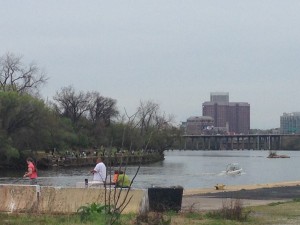Hop along the rocks at Belle Isle on a warm April day, and you will find a variety of different people taking advantage of all the leisure and recreational activities that the James has to offer.
College kids lay out to escape the stresses of exams, families bring their kids to the water after work, and other individuals will be knee deep, wading and fishing for dinner tonight.
 Naturally, in areas that have this level of human traffic, trash and other pollutants tend to pile up. It was not uncommon to see beer cans and other trash left behind from previous excursions.
Naturally, in areas that have this level of human traffic, trash and other pollutants tend to pile up. It was not uncommon to see beer cans and other trash left behind from previous excursions.
Some of the locals I spoke to, those that had been in Richmond for a long time, knew a thing or two about the conservation efforts that went on behind the scenes to keep the river inhabitable for everyone. Others, more of the newcomers, admitted to not knowing as much about the subject but were willing to be supportive and were interested in getting involved. For a first hand look at the route we walked and the interviews we did, check out our Mapping the James dispatch.
The James River Association is a leading conservation and education group in the Richmond area. Their mission is to be the guardian of the James and to take action to conserve the river as well as be responsible stewards of the natural resources.
Justin Doyle, the Community Conservation Manager at the JRA, works to connect people with the James and helps communities understand the benefits of a healthy James River.
Doyle said that there were both quality of life benefits, through the recreational uses, as well as economic benefits that stem from the same outdoor activity and tourism.
One of the projects that Doyle is currently working on, the Richmond Riverfront Plan, improves connections through Richmond’s riverfront as well as makes public space enhancements.
“I love the job and working with anyone in the community who has an interest in the James,” Doyle said. “But I also enjoy working with people appreciate and develop a relationship and hopefully want to take action to protect it.”
While pollution on the James has decreased greatly in the last years due to the conservation put on by the JRA and others, it is still not entirely clean. You can check out an interactive map that grades that state of the James here.
Coal Ash Wastewater
In mid-January of this year, Dominion Power applied for a permits to dump coal ash wastewater into the James. It was approved by the Virginia Statewater Controlboard. It has raised many concerns about where the state of the river will be, and whether or not it will affect recreational use and wildlife negatively.

Community members of all ages gathered to mourn the James on Earth Day after coal ash water dumping permits were approved.
In an effort to speak out, many members in the community came together on Earth Day to have a “funeral” for the James. The effort was put on by Trillium Collective, which is an organization that promotes art and performance activism. They wore black and tried to raise awareness about the Dominion wastewater issue.
Doyle does not work directly with policy issues such as this one, but the JRA did work closely with Dominion after it got its permits approved to lessen the damage as much as possible.
“I can’t say much about it, but I think the overall impact will be negligible,” Doyle said.
Keeping the river clean and fun for all parties involved can be a challenge, but getting involved with conservation efforts such as the JRA is the first step towards a healthy river system in the river city.
